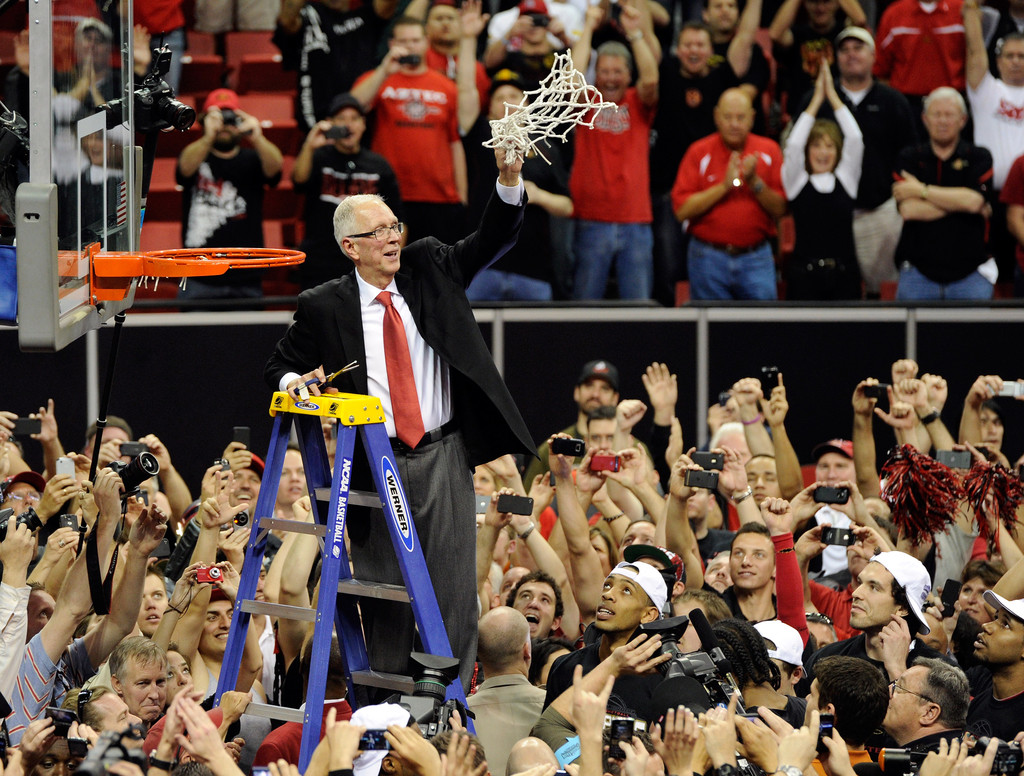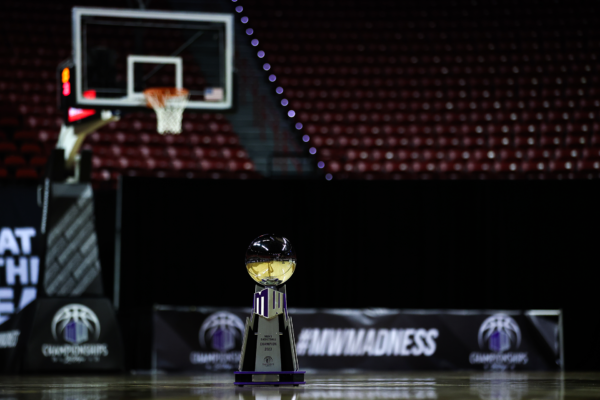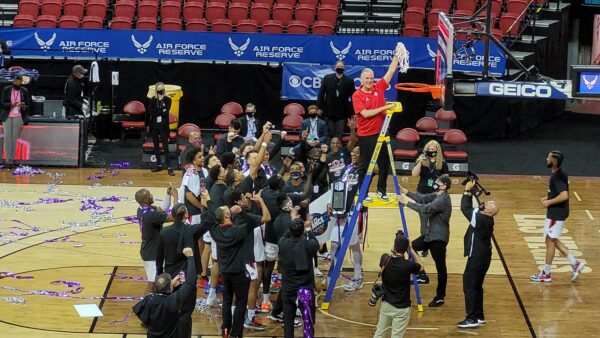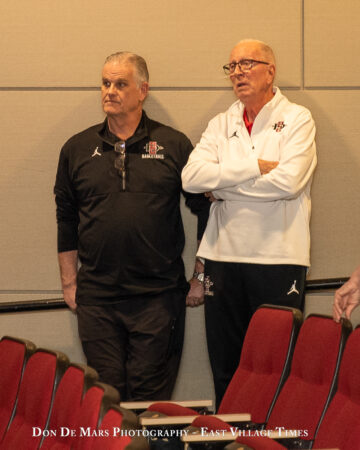The Mountain West Tournament is great; it could be even better

Credit: AP Photo (August 28, 2012)

The 2024 Mountain West (MW) Men’s Basketball Tournament promises to be among the best in conference history. A strong argument can be made to anoint seven of the eleven teams as favorites to earn the automatic bid to the NCAA tournament.
Utah State won the outright regular season title. Without the unbalanced schedule, Nevada would likely be the No.1 seed. They defeated the Aggies in Logan but did not get a return visit to try and even the teams’ conference records. Boise State, fresh off-ending SDSU’s home winning streak, has size, three-point shooting, and experience to win multiple ways.
UNLV has the built-in advantage of hosting the event. They are also among the most desperate. Their only path to the postseason involves winning the tournament on their home court. SDSU is arguably the most skilled team overall and boasts the best player in the conference in Jaedon LeDee. In the play-in games, New Mexico and Colorado State need to pad their NCAA resumes for at-large bids. Both have the key ingredient for success in March, great guard play.
More than just the depth and parity, the 2024 iteration has teams playing at the highest level of college basketball. Place the favorites from the MW tourney (except for UNLV) in postseason playoffs around the country, and they would threaten to win those leagues as well.
As great as this year’s tournament should be, some changes could be made to make it even better. With the announcement that the conference will have a true round-robin, 20-game conference schedule beginning next season, the time is perfect to calibrate what has grown into one of the best collegiate basketball events in the country.
Hosting should be earned
With the demise of the Pac-12, the Mountain West has become the preeminent conference in the western part of the United States. Seizing upon the opportunity granted by conference realignment involves more than just PR moves like announcing five-year initiatives. If the MW wants to take its place in the middle class of college sports alongside the Big XII and ACC, action and investment is needed.

The revitalization of the Mountain West Network to feature its programs has been a good step and is what major conferences should do. Bridging the technology gaps with big-budget leagues, like forcing its baseball teams to have replay capabilities in place for next season, is another move the MW has made to shed its budget-crunching reputation.
Another step toward prominence for the MW would be ending its policy of allowing UNLV to host the conference tournament each year. Devoid of a logically neutral site city that wouldn’t provide a competitive advantage to one of its programs, the conference should award its regular-season champion from the previous season the opportunity to host the tournament.
The MW member cities are underrated. From the beauty of Fort Collins and Colorado Springs to the major metropolises of San Diego and Las Vegas, there are terrific places to visit. Featuring the universities’ locations to its own fans would help create pride in the conference.
Seen more as a hopeful stepping stone than a permanent home, using the conference tournament as a way to build the MW brand to its supporters would be a wise decision.
Playing in the cities of its regular season champions would provide a competitive advantage to whoever earned the right. Due primarily to UNLV’s postseason ineptitude, the MW has been shielded from the embarrassment of favoring one of its member schools so acutely.
If this issue proves too much of a concern, the MW could award the champion the opportunity to host two seasons after it won the regular season title. With NIL and the transfer portal, rosters are virtually remade every couple of years.
If this change had been in place over the past decade, San Diego (5 times), Reno (3), and Boise (2) would have rotated as hosts. Imagine the euphoria and celebration this time next year in Logan, Utah, if the conference makes the change.
The Mountain West wants to raise its profile nationally. Providing a competitive advantage to one of its teams by allowing it to host the conference tournament every season in Las Vegas sends the opposite message.
Add a day off to the schedule
Traditionally, the best MW basketball all season is played in the semifinals of the conference tournament. The two games on Friday night showcase the high level the teams compete at all year. To anyone watching, it proves the substance of the conference.
Unfortunately, the ugliest basketball game of the season is usually the championship the following day. The last time both teams reached 60 points in the final was in 2018, when SDSU defeated New Mexico 82-75. That contest was also the last time any team reached 70 points.

The 2020 tournament is an informative example of what happens to the teams’ offenses after such a grueling stretch. SDSU was 30-1 heading into the final. Led by Malachi Flynn, the Aztecs had their best offense in team history. Leading up to the game, they easily dispatched Air Force (73-60) and Boise State (81-68). In the final, they met Utah State, another high-scoring team that averaged 82 points in their two wins before the last game. Despite being led by a pair of future NBA point guards, the finals was an unskilled rock fight that the Aggies won 59-56.
The main culprit for the offensive deficiency is tired legs. Outside shooting is at a premium as a result of playing three or four games in consecutive days. In the past five years, there have been a total of 191 three-point attempts in the championship game. Only 25.1% of them (41) have been hit. SDSU’s 6-of-12 performance in 2022 is the only time a team shot better than 38% from deep in that span.
The poor optics are heightened because the semifinals are aired late in the evening on CBS Sports Network. This year’s games are scheduled to tip off at 9 pm and 12 am on the East Coast. The final, in contrast, is on the main CBS in a primetime spot at 6 pm.
Over the last five seasons, the average outcome was 61-56, with a combined shooting percentage of just 37.5%. Is it any wonder MW basketball is known nationally as a league with tough athletes who win through effort more than skill?
The fix is simple. Move the men’s tournament back one day to create an off day. The title game should be seen as the showcase event for the conference.
Take Friday off to rest and game plan so the contest can be of the same high quality as the rest of the season. A Thursday day off after the quarterfinals could also work if that was more palatable to the television partners.
Name the championship trophy after Steve Fisher
In October, the MW honored its former commissioner by making him the namesake for the Craig Thompson Championship Trophy. Men’s basketball should follow suit and name its trophy after its most influential coach, SDSU’s Steve Fisher.
Fisher’s first season on The Mesa coincided with the beginning of the Mountain West. For 18 years, as coaches came and went from other institutions, Fisher was the face of MW basketball. He holds the records for most games coached and won by significant margins. More importantly, he proved with his work at SDSU that teams in the MW can attain greatness.
Two months ago, the conference released a five-year strategic plan with the moniker Ascend Together: Our Path to Excellence. Fisher embodied this ethos.

If a Cinderella wins the tournament this week, more than 60% of the MW’s teams could be in the NCAA Tournament. Fisher created and provided the blueprint for how to build a program in the shadow of the power leagues.
At the advent of the conference, Utah and BYU were consistently the crème of the conference. They left. Even when present members, UNLV, New Mexico, Air Force, or Wyoming, paced the league, their recipes were particular to their institutions and did not have the sustainability of Fisher’s model.
A look around the MW in 2024 reveals squads built in SDSU’s mold. In many ways, the Aztecs’ fifth-place finish in the regular season was because their opponents were more Aztec-like than them. Long athletes who can guard multiple positions and rebound used to only be SDSU’s calling card. Now, it is the entire conference. That is Fisher’s legacy.
Part of reaching the heights the MW aspires to is creating a tradition that resonates with its fans. Outside of San Diego, Fisher is still more commonly known as the coach of the Fab Five. Rebranding the trophy would highlight Fisher’s true impact on college basketball. He democratized the game, and he did it in the Mountain West.
My earliest sport’s memory involve tailgating at the Murph, running down the circular exit ramps, and seeing the Padres, Chargers and Aztecs play. As a second generation Aztec, I am passionate about all things SDSU. Other interests include raising my four children, being a great husband and teaching high school.